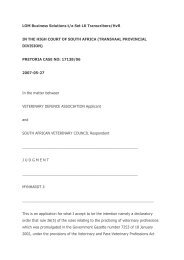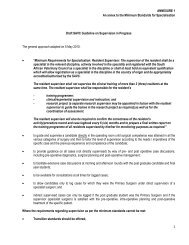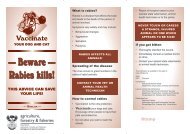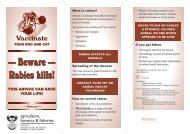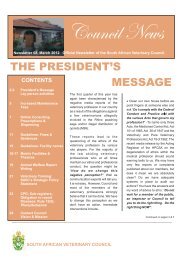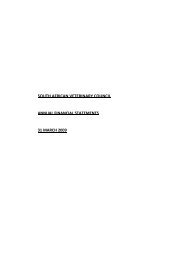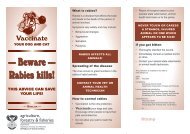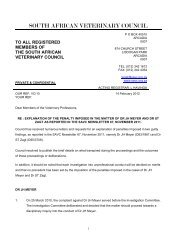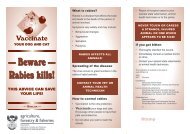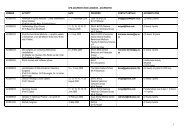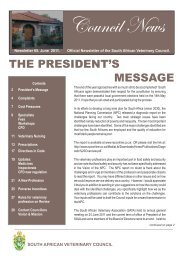Rabies Guide 2010.pdf - the South African Veterinary Council
Rabies Guide 2010.pdf - the South African Veterinary Council
Rabies Guide 2010.pdf - the South African Veterinary Council
You also want an ePaper? Increase the reach of your titles
YUMPU automatically turns print PDFs into web optimized ePapers that Google loves.
vaccine product be used for an entire vaccine series.<br />
It may however be necessary to change <strong>the</strong> product<br />
when <strong>the</strong> patient exhibits sensitivity to <strong>the</strong> one<br />
product. 170<br />
Unlike earlier central nervous system derived vaccines,<br />
for example Semple and suckling mouse-brain<br />
products, PCECV and PVCV, have an excellent safety<br />
profile. The former vaccines are still widely used in<br />
developing countries because of <strong>the</strong>ir affordability<br />
However, <strong>the</strong>ir uncertain immunogenicity and<br />
accompanying risk of severe neurological adverse<br />
reactions, with a frequency of between 1 in 120 to<br />
1 in 1 200 vaccine recipients, make <strong>the</strong>m a poor<br />
option. 124,125,126<br />
Adverse events to modern cell culture vaccines are<br />
uncommon and severe reactions are exceedingly<br />
rare with <strong>the</strong>se vaccines. 127,128,129 Single cases of<br />
peripheral polyneuropathy, and o<strong>the</strong>r local and<br />
systemic reactions such as itchiness, fever, urticaria<br />
and arthralgia are experienced in a very small<br />
proportion of patients. 130,131,132,133 <strong>Rabies</strong> vaccine has<br />
been extensively used in pregnancy without any<br />
adverse sequelae. 134 Pregnancy and infancy are not<br />
contraindications for rabies vaccination with cell<br />
culture vaccine if <strong>the</strong> risk of rabies virus transmission<br />
is considered significant. Any adverse events should<br />
be notified to <strong>the</strong> relevant provincial and national<br />
officials for full investigation.<br />
It is essential that <strong>the</strong> cold chain be maintained with<br />
rabies vaccine kept between 2 and 8 °C during all<br />
handling and storage. Vaccine must be used on <strong>the</strong><br />
day opened. Unused vaccine must be discarded.<br />
All patients should be observed for an hour after<br />
receiving vaccine and an emergency pack for treating<br />
anaphylaxis should be available.<br />
The flow diagram in Fig. 7 (page 41 or Appendix<br />
2) provides a useful approach to <strong>the</strong> person with a<br />
suspected rabies exposure. This should be reproduced<br />
and made available in all clinics and hospital casualty<br />
units in rabies endemic areas.<br />
40



